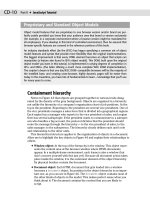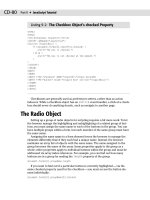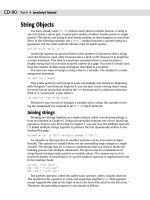JavaScript Bible, Gold Edition part 5 doc
Bạn đang xem bản rút gọn của tài liệu. Xem và tải ngay bản đầy đủ của tài liệu tại đây (108.53 KB, 10 trang )
4
Part I ✦ Getting Started with JavaScript
standards, tools, and other technologies at your disposal. The alternative technolo-
gies described in this chapter are HTML, server programs, plug-ins, and Java
applets. In most cases, JavaScript can work side by side with these other technolo-
gies, even though the hype around some make them sound like one-stop shopping
places for all your interactive needs. That’s rarely the case. Finally, you learn about
the origins of JavaScript and what role it plays in today’s advanced Web browsers.
Competition on the Web
Web page publishers revel in logging as many visits to their sites as possible.
Regardless of the questionable accuracy of Web page hit counts, a site consistently
logging 10,000 dubious hits per week is clearly far more popular than one with 1,000
dubious hits per week. Even if the precise number is unknown, relative popularity is
a valuable measure.
Encouraging people to visit a site frequently is the Holy Grail of Web publishing.
Competition for viewers is enormous. Not only is the Web like a ten million-channel
television, but the Web competes for viewers’ attention with all kinds of computer-
generated information. That includes anything that appears onscreen as interactive
multimedia.
Users of entertainment programs, multimedia encyclopedias, and other colorful,
engaging, and mouse finger-numbing actions are accustomed to high-quality
presentations. Frequently, these programs sport first-rate graphics, animation, live-
action video, and synchronized sound. In contrast, the lowest common denomina-
tor Web page has little in the way of razzle-dazzle. Even with the help of recent
advances in Dynamic HTML and style sheets, the layout of pictures and text is
highly constrained compared with the kinds of desktop publishing documents you
see all the time. Regardless of the quality of its content, a vanilla HTML document is
flat. At best, interaction is limited to whatever navigation the author offers in the
way of hypertext links or forms whose filled-in content magically disappears into
the Web site’s server.
With so many ways to spice up Web sites and pages, you can count on competi-
tors for your site’s visitors to do their darndest to make their sites more engaging
than yours. Unless you are the sole purveyor of information that is in high demand,
you continually must devise ways to keep your visitors coming back and entice new
ones. If you design an intranet, your competition is the drive for improved produc-
tivity by the colleagues who use the internal Web sites for getting their jobs done.
These are all excellent reasons why you should care about using one or more
Web technologies to raise your pages above the noise. Let’s look at the major tech-
nologies you should know about.
Hypertext Markup Language (HTML)
As an outgrowth of SGML (Standard Generalized Markup Language), HTML is gen-
erally viewed as nothing more than a document formatting, or tagging, language.
The tags (inside
<> delimiter characters) instruct a viewer program (the browser or,
more generically, the client) how to display chunks of text or images.
5
Chapter 1 ✦ JavaScript’s Role in the World Wide Web and Beyond
Relegating HTML to the category of a tagging language does disservice not only
to the effort that goes into fashioning a first-rate Web page, but also to the way
users interact with the pages. To my way of thinking, any collection of commands
and other syntax that directs the way users interact with digital information is pro-
gramming. With HTML, a Web page author controls the user experience with the
content just as the engineers who program Microsoft Excel craft the way users
interact with spreadsheet content and functions.
Recent enhancements to the published standards for HTML (HTML 4.0 and later)
endeavor to define more narrowly the purpose of HTML to assign context to con-
tent, leaving the appearance to a separate standard for style sheets. In other words,
it’s not HTML’s role to signify that some text is italic, but rather to signify why it is
italic. (For example, you tag a chunk of text that conveys emphasis regardless of
how the style sheet or browser sets the appearance of that emphasized text.)
The most interactivity that HTML lets authors play with is associated with
fill-in-the-blank forms. Browsers display text boxes, radio buttons, checkboxes, and
select lists in response to HTML tags for those types of form controls. But that’s as
far as HTML goes. Any processing of the choices or information entered into the
form by the user is the job of other technologies, such as programs on the server or
client-side scripts.
CGI Scripting
One way to enhance the interaction between user and content is to have the page
communicate with the Web server that houses the Web pages. Popular Web search
sites, such as Yahoo!, Google, and Lycos, enable users to type search criteria and
click a button or two to specify the way the search engine should treat the query.
E-commerce sites enable you to gather products in a virtual shopping cart and then
click a button to submit an order for processing. When you click the Submit or
Search buttons, your browser sends your entries from a form to the server. On the
server, a program known as a CGI (Common Gateway Interface) script formats the
data you enter and sends this information to a database or other program running
on the server. The CGI script then sends the results to your browser, sometimes in
the form of a new page or as information occupying other fields in the form.
Writing customized CGI scripts typically requires considerable programming
skill. Most CGI scripts are written in languages such as Perl, Java, and C or C++.
Very few servers are equipped to run server scripts written in JavaScript.
Whatever language you use, the job definitely requires the Web page author to
be in control of the server, including whatever back-end programs (such as
databases) are needed to supply results or massage the information coming from
the user. Even with the new, server-based Web site design tools available, CGI
scripting often is not a task that a content-oriented HTML author can do without
handing it off to a more experienced programmer.
As interesting and useful as CGI scripting is, it burdens the server with the job of
processing queries. A busy server may process hundreds of CGI scripts at a time,
while the client computers — the personal computers running the browsers — sit
idle as the browser’s logo icon dances its little animation. This wastes desktop pro-
cessing horsepower, especially if the process running on the server doesn’t need to
6
Part I ✦ Getting Started with JavaScript
access big databases or other external computers. That’s why some people regard
browsing a basic Web page as little more than using a dumb terminal to access
some server content.
Of Helpers and Plug-ins
In the early days of the World Wide Web, a browser needed to present only a few
kinds of data before a user’s eyes. The power to render text (tagged with HTML)
and images (in popular formats such as GIF and JPEG) was built into browsers
intended for desktop operating systems. Not to be limited by those data types,
developers worked hard to extend browsers so that data in other formats could be
rendered on the client computer. It was unlikely, however, that a browser would
ever be built that could download and render, say, any of several sound file formats.
One way to solve the problem was to allow the browser, upon recognizing an
incoming file of a particular type, to launch a separate application on the client
machine to render the content. As long as this helper application was installed on
the client computer (and the association with the helper program set in the
browser’s preferences), the browser would launch the program and send the
incoming file to that program. Thus, you might have one helper application for a
MIDI sound file and another for a WAV sound file.
Beginning with Netscape Navigator 2, software plug-ins for browsers enabled
developers to extend the capabilities of the browser without having to modify the
browser. Unlike a helper application, a plug-in can enable external content to blend
into the document seamlessly.
The most common plug-ins are those that facilitate the playback of audio and
video from the server. Audio may include music tracks that play in the background
while visiting a page or live (streaming) audio, similar to a radio station. Video and
animation can operate in a space on the page when played through a plug-in that
knows how to process such data.
Today’s browsers tend to ship with plug-ins that decode the most common
sound file types. Developers of plug-ins for Internet Explorer for the Windows oper-
ating system commonly implement plug-ins as ActiveX controls — a distinction that
is important to the underpinnings of the operating system, but not to the user.
Plug-ins and helpers are valuable for more than just audio and video playback. A
popular helper application is the Adobe Acrobat Reader, which displays Acrobat
files that are formatted just as if they were being printed. But for interactivity,
developers today frequently rely on Macromedia Corporation’s Flash plug-in.
Created using the Macromedia Flash authoring environment, a Flash document can
have active clickable areas and draggable elements. Some authors even simulate
artistic video games and animated stories in Flash. A browser equipped with the
Flash plug-in displays the content in a rectangular area embedded within the
browser page.
One potential downside for authoring interactive content in Flash or similar
environments is that if the user does not have the plug-in installed, it can take some
time to download the plug-in (if the user even wants to bother). Moreover, once the
plug-in is installed, highly graphic and interactive content can take longer to down-
load to the client (especially on a dial-up connection) than some users are willing to
wait. This is one of those situations in which you must balance your creative
palette with the user’s desire for your interactive content.
7
Chapter 1 ✦ JavaScript’s Role in the World Wide Web and Beyond
Java Applets
When the interaction between user and Web page exceeds the capabilities of
HTML, experienced programmers may prefer to “roll their own” programs to handle
the special needs not available in existing plug-ins. The Java programming language
fills this need. Developed by Sun Microsystems, this language enables programmers
to write small applications (applets) that download to the browser as separate files.
An applet runs as the user needs it and then is automatically discarded from mem-
ory when the user moves elsewhere in the Web.
Animation, including animated text whose content can change over time, is a
popular application of the Java applet in an HTML page. Because applets can also
communicate with the Internet as they run (it is a very network-centric program-
ming language), they are also used for real-time, data-streaming applications that
display up-to-the-minute news, stock market, and sports data as this information
comes across the wires. Standard HTML content can surround all of this activity as
the Web page designer sees fit.
To play a Java applet, a browser company must license the technology from Sun
and build it into its browser (or link up with a Java engine that is part of the operat-
ing system). Netscape was the first third-party browser supplier to license and pro-
duce a browser capable of running Java applets (Navigator 2 under Windows 95 and
UNIX). Today, both Netscape Navigator and Microsoft Internet Explorer (IE) can
load and run Java applets on almost every operating system platform supported by
the browser.
Despite a flash of popularity in the early Java days, Java is used less and less for
browser applets. It is quite popular, however, on the server, where it is used fre-
quently to create small server application modules called servlets. On the client,
Java applets suffer the same problem as some plug-ins: the delay required to down-
load the file. Also, not every browser is equipped with the desired Java component,
causing potential compatibility conflicts.
JavaScript: A Language for All
The Java language is derived from C and C++, but it is a distinct language. Its
main audience is the experienced programmer. That leaves out many Web page
authors. I was dismayed at this situation when I first read about Java’s specifica-
tions. I would have preferred a language that casual programmers and scripters
who were comfortable with authoring tools such as Apple’s once-formidable
HyperCard and Microsoft’s Visual Basic could adopt quickly. As these accessible
development platforms have shown, nonprofessional authors can dream up many
creative applications, often for very specific tasks that no professional programmer
would have the inclination to work on. Personal needs often drive development in
the classroom, office, den, or garage. But Java was not going to be that kind of inclu-
sive language.
My spirits lifted several months later, in November 1995, when I heard of a script-
ing language project brewing at Netscape. Initially born under the name LiveScript,
this language was developed in parallel with Netscape’s Web server software. The
language was to serve two purposes with the same syntax. One purpose was as a
8
Part I ✦ Getting Started with JavaScript
scripting language that Web server administrators could use to manage the server
and connect its pages to other services, such as back-end databases and search
engines for users looking up information. Extending the “Live” brand name further,
Netscape assigned the name LiveWire to the database connectivity usage of
JavaScript on the server.
On the client side — in HTML documents — authors could employ scripts written
in this new language to enhance Web pages in a number of ways. For example, an
author could use LiveScript to make sure that the information a user enters into a
form is of the proper type. Instead of forcing the server or database to do the data
validation (requiring data exchanges between the client browser and the server),
the user’s computer handles all the calculation work — putting some of that other-
wise wasted horsepower to work. In essence, LiveScript could provide HTML-level
interaction for the user.
As the intensity of industry interest in Java grew, Netscape saw another opportu-
nity for LiveScript: as a way for HTML documents (and their users) to communicate
with Java applets. For example, a user might make some preference selections from
checkboxes and pop-up selection lists located at the top of a Web page. Scrolling
down to the next screenful, the user sees text in the Java applet scrolling banner on
the page that is customized to the settings made above. In this case, the LiveScript
script sends the text that is to appear in the scrolling banner to the applet (and per-
haps a new color to use for the banner’s background and text). While this is hap-
pening, the server doesn’t have to worry a bit about it, and the user hasn’t had to
wait for communication between the browser and the server. As great an idea as
this was initially, this connectivity feature didn’t make it into Navigator 2 when
JavaScript first became available.
LiveScript becomes JavaScript
In early December 1995, just prior to the formal release of Navigator 2, Netscape
and Sun jointly announced that the scripting language thereafter would be known
as JavaScript. Though Netscape had several good marketing reasons for adopting
this name, the changeover may have contributed more confusion to both the Java
and HTML scripting worlds than anyone expected.
Before the announcement, the language was already related to Java in some
ways. Many of the basic syntax elements of the scripting language were reminiscent
of the C and C++ style of Java. For client-side scripting, the language was intended
for very different purposes than Java — essentially to function as a programming
language integrated into HTML documents rather than as a language for writing
applets that occupy a fixed rectangular area on the page (and that are oblivious to
anything else on the page). Instead of Java’s full-blown programming language
vocabulary (and conceptually more difficult to learn object-oriented approach),
JavaScript had a small vocabulary and a more easily digestible programming
model.
The true difficulty, it turned out, was making the distinction between Java and
JavaScript clear to the world. Many computer journalists made major blunders
when they said or implied that JavaScript provided a simpler way of building Java
applets. To this day, many programmers believe JavaScript is synonymous with the
Java language: They post Java queries to JavaScript-specific Internet newsgroups
and mailing lists.
9
Chapter 1 ✦ JavaScript’s Role in the World Wide Web and Beyond
The fact remains today that Java and JavaScript are more different than they are
similar. The two languages employ entirely different interpreter engines to execute
their lines of code. Whereas JavaScript support shipped in every platform-specific
version of Navigator 2 in February 1996, Java was not available for Windows 3.1
users until late in the life of Navigator 3. (Many squirrelly technical issues make it
difficult for this modern language to work in an “ancient” MS-DOS operating system.)
The Microsoft world
Although the JavaScript language originated at Netscape, Microsoft acknowl-
edged the potential power and popularity of the language by implementing it
(under the JScript name) in Internet Explorer 3. Even if Microsoft would rather that
the world use the VBScript (Visual Basic Script) language that it provides in the
Windows versions of IE, the fact that JavaScript is available on more browsers and
operating systems makes it the client-side scripter’s choice for anyone who must
design for a broad range of users.
In keeping with the competitive nature of the Web browser market, Netscape and
Microsoft continue to attract developers to their camps with different philosophies.
As this book is written, Netscape is waving the banner of support for published
Web standards; Microsoft, on the other hand, provides only partial standards
support but many proprietary extensions that are useful, especially when the
clients are running Win32 operating systems exclusively. If you develop pages for
an audience that uses both browser brands and multiple operating systems, this
creates challenges. I address these issues in the next chapter and in several techni-
cal sections in Parts III and IV.
JavaScript: The Right Tool for the Right Job
Knowing how to match an authoring tool to a solution-building task is an impor-
tant part of being a well-rounded Web page author. A Web page designer who
ignores JavaScript is akin to a plumber who bruises his knuckles by using pliers
instead of the wrench at the bottom of the toolbox.
By the same token, JavaScript won’t fulfill every dream. The more you under-
stand about JavaScript’s intentions and limitations, the more likely you will be to
turn to it immediately when it is the proper tool. In particular, look to JavaScript for
the following kinds of solutions:
✦ Getting your Web page to respond or react directly to user interaction with
form elements (input fields, text areas, buttons, radio buttons, checkboxes,
selection lists) and hypertext links — a class of application I call the
serverless CGI
✦ Distributing small collections of database-like information and providing a
friendly interface to that data
✦ Controlling multiple-frame navigation, plug-ins, or Java applets based on user
choices in the HTML document
✦ Preprocessing data on the client before submission to a server
✦ Changing content and styles in modern browsers dynamically and instantly in
response to user interaction
10
Part I ✦ Getting Started with JavaScript
At the same time, understanding what JavaScript is not capable of doing is vital.
Scripters waste many hours looking for ways of carrying out tasks for which
JavaScript was not designed. Most of the limitations are designed to protect visitors
from invasions of privacy or unauthorized access to their desktop computers.
Therefore, unless a visitor uses a modern browser and explicitly gives you
permission to access protected parts of his or her computer, JavaScript cannot
surreptitiously perform any of the following actions:
✦ Setting or retrieving the browser’s preferences settings, main window
appearance features, action buttons, and printing
✦ Launching an application on the client computer
✦ Reading or writing files or directories on the client or server computer
✦ Capturing live data streams from the server for retransmission
✦ Sending secret e-mails from Web site visitors to you
Web site authors are constantly seeking tools that will make their sites engaging
(if not “cool”) with the least amount of effort. This is particularly true when the task
is in the hands of people more comfortable with writing, graphic design, and page
layout than with hard-core programming. Not every Webmaster has legions of expe-
rienced programmers on hand to whip up some special, custom enhancement for
the site. Nor does every Web author have control over the Web server that physi-
cally houses the collection of HTML and graphics files. JavaScript brings program-
ming power within reach of anyone familiar with HTML, even when the server is a
black box at the other end of a telephone line.
✦✦✦
Authoring
Challenges
Amid the
Browser Wars
I
f you are starting to learn JavaScript at this point in the
brief history of scriptable browsers, you have both a dis-
tinct advantage and disadvantage. The advantage is that you
have the wonderful capabilities of the latest browser offerings
from Netscape and Microsoft at your bidding. The disadvan-
tage is that you have not experienced the painful history of
authoring for older browser versions that were buggy and at
times incompatible with one another due to a lack of stan-
dards. You have yet to learn the anguish of carefully devising
a scripted application for the browser version you use only to
have site visitors sending you voluminous e-mail messages
about how the page triggers all kinds of script errors when
run on a different browser brand, generation, or operating
system platform.
Welcome to the real world of scripting Web pages in
JavaScript. Several dynamics are at work to help make an
author’s life difficult if the audience for the application uses
more than a single type of browser. This chapter introduces
you to these challenges before you type your first word of
JavaScript code. My fear is that the subjects I raise may dis-
suade you from progressing further into JavaScript and its
powers. But as a developer myself — and as someone who has
been using JavaScript since the earliest days of its public pre-
release availability — I dare not sugarcoat the issues facing
scripters today. Instead, I want to make sure you have an
appreciation of what lies ahead to assist you in learning the
language. I believe if you understand the big picture of the
browser-scripting world as it stands at the start of the year
2001, you will find it easier to target JavaScript usage in your
Web application development.
2
2
CHAPTER
✦✦✦✦
In This Chapter
How leapfrogging
browser develop-
ments hurt Web
developers
Separating the core
JavaScript language
from document
objects
The importance of
developing a cross-
browser strategy
✦✦✦✦
12
Part I ✦ Getting Started with JavaScript
Leapfrog
Browser compatibility has been an issue for authors since the earliest days of
rushing to the Web — long before JavaScript. Despite the fact that browser develop-
ers and other interested parties voiced their opinions during formative stages of
standards development, HTML authors could not produce a document that
appeared the same pixel by pixel on all client machines. It may have been one thing
to establish a set of standard tags for defining heading levels and line breaks, but it
was rare for the actual rendering of content inside those tags to look identical on
different brands of browsers.
Then, as the competitive world heated up — and Web browser development
transformed itself from a volunteer undertaking into profit-seeking businesses —
creative people defined new features and new tags that helped authors develop
more flexible and interesting looking pages. As happens a lot in any computer-
related industry, the pace of commercial development easily outpaced the studied
processing of standards. A browser maker would build a new HTML feature into a
browser and only then propose that feature to the relevant standards body. Web
authors were using these features (sometimes for prerelease browser versions)
before the proposals were published for review.
When the deployment of content depends almost entirely on an interpretive
engine on the client computer receiving the data — the HTML engine in a browser,
for example — authors face an immediate problem. Unlike a standalone computer
program that can extend and even invent functionality across a wide range and
have it run on everyone’s computer (at least for a given operating system), Web
content providers must rely on the functionality built into the browser. This led to
questions such as, “If not all browsers coming to my site support a particular HTML
feature, then should I apply newfangled HTML features for visitors only at the
bleeding edge?” and “If I do deploy the new features, what do I do for those with
older browsers?”
Authors who developed pages in the earliest days of the Web wrestled with
these questions for many HTML features that we today take for granted. Tables and
frames come to mind. Eventually, the standards caught up with the proposed HTML
extensions — but not without a lot of author anguish along the way.
The same game continues today. But the field of players has shrunk to two pri-
mary players: Netscape and Microsoft. The independent Opera browser runs a
distant third in the browser race. For all of these companies, the stakes are higher
than ever before — market share, investor return on investment, and so on. Pick a
business buzzword, and you’ll find a reason behind the competition. What had
begun years ago as a friendly game of leapfrog (long before Microsoft even
acknowledged the Web) has become an out-and-out war.
Duck and Cover
Sometimes it is difficult to tell from week to week where the battles are being
fought. Marketing messages from the combatants turn on a dime. You can’t tell if
the message is proactive to stress a genuinely new corporate strategy or reactive to
match the opponent’s latest salvo. The combatants keep touting to each other:
“Anything you can do, we can do better!” Or, in a more recent salvo: “We support
Web standards!” and “We integrate seamlessly with the operating system!”
13
Chapter 2 ✦ Authoring Challenges Amid the Browser Wars
If it were a case of Netscape and Microsoft pitching their server and browser
software to customers for the creation of monolithic intranets, I could understand
and appreciate such efforts. The battle lines would be clearly drawn, and potential
customers would base their decisions on unemotional criteria — how well the solu-
tion fits the customer’s information distribution and connectivity goals. In fact, if
you develop for an organization-wide intranet, whose browser choice is dictated by
management, you are in luck because authoring for a single browser brand and
version is a piece of cake. But you are not in the majority.
As happens in war, civilian casualties mount when the big guns start shooting.
The battle lines have shifted dramatically in only a few years. The huge market
share territory once under Netscape’s command now lies in Microsoft hands (no
doubt aided by the millions of America Online users who receive IE as part of the
AOL software). While a fair amount of authoring common ground exists between
the latest versions of the two browsers, the newest features cause the biggest
problems for authors wishing to deploy on both browsers. Trying to determine
where the common denominator is may be the toughest part of the authoring job.
Compatibility Issues Today
Allow me to describe the current status of compatibility between Netscape
Navigator and Internet Explorer. The discussion in the next few sections intention-
ally does not get into specific scripting technology very deeply — some of you may
know very little about programming. In many chapters throughout Parts III and IV, I
offer scripting suggestions to accommodate both browsers.
Separating language from objects
Although early JavaScript authors initially treated client-side scripting as one
environment that permitted the programming of page elements, the scene has
changed as the browsers have matured. Today, a clear distinction exists between
specifications for the core JavaScript language and for the elements you script in a
document (for example, buttons and fields in a form).
On one level, this separation is a good thing. It means that one specification
exists for basic programming concepts and syntax that enables you to apply the
same language to environments that may not even exist today. You can think of the
core language as basic wiring. Once you know how electric wires work, you can
connect them to all kinds of electrical devices, including some that may not be
invented yet. Similarly, JavaScript today is used to wire together page elements in
an HTML document. Tomorrow, operating systems could use the core language to
enable users to wire together desktop applications that need to exchange informa-
tion automatically.
At the ends of today’s JavaScript wires are the elements on the page. In program-
ming jargon, these items are known as document objects. By keeping the specifica-
tions for document objects separate from the wires that connect them, you can use
other kinds of wires (other languages) to connect them. It’s like designing tele-
phones that can work with any kind of wire, including a type of wire that hasn’t
been invented yet. Today the devices can work with copper wire or fiber optic
cable. You get a good picture of this separation in Internet Explorer, whose set of
document objects can be scripted with JavaScript or VBScript. They’re the same
objects, just different wiring.









